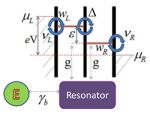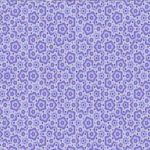EPJ B - Spurious switching points in traded stock dynamics
- Details
- Published on 10 August 2012

A selection of biased statistical subsets could yield an inaccurate interpretation of market behaviour and financial returns.
Physicists have rebuffed the existence of power laws governing the dynamics of traded stock volatility, volume and intertrade times at times of stock price extrema. They did this by demonstrating that what appeared as “switching points” in financial markets trends was due to a bias in the interpretation of market data statistics. This study by Vladimir Filimonov and Didier Sornette from the Department of Management, Technology and Economics at ETH Zurich in Switzerland has just been published in EPJB.EPJ B - Superconducting stripe could become an ultra-low-voltage sensor
- Details
- Published on 10 August 2012

Minute-scale interactions govern electronic behaviour of superconductors with potential applications for voltage measurement techniques.
Researchers studying a superconducting stripe observed an intermittent motion of magnetic flux which carries vortices inside the regularly spaced weak conducting regions carved into the superconducting material. These vortices resulted in alternating static phases with zero voltage and dynamic phases, which are characterised by non-zero voltage peaks in the superconductor. This study, which has just been published in EPJB, was carried out by scientists from the Condensed Matter Theory Group of the University of Antwerp, Belgium, working in collaboration with Brazilian colleagues.
EPJ B - Quantum information motion control is now improved
- Details
- Published on 10 August 2012

Model simulates closer control over the transport of information-carrying electrons.
Physicists have recently devised a new method for handling the effect of the interplay between vibrations and electrons on electronic transport. Their paper has been published in EPJB. This study, led by scientists from Zhejiang University, Hangzhou, China, and the Centre for Computational Science and Engineering at the National University of Singapore, could have implications for quantum computers due to improvements in the transport of discrete amounts of information, known as qubits, that are encoded in electrons.
EPJ B - Market exchange rules responsible for wealth concentration
- Details
- Published on 10 August 2012

Next year’s Davos meeting could benefit from physicists’ insights on how new market rules help avoid wealth concentration.
Two Brazilian physicists have shown that wealth concentration invariably stems from a particular type of market exchange rules – where agents cannot receive more income than their own capital. The authors concluded that maximum inequalities ensue from free markets, which are governed by such seemingly fair rules. This study, published in EPJB was conducted by J. Roberto Iglesias and Rita de Almeida from the Brazilian National Institute of Science and Technology of Complex Systems, based in Porto Alegre. This Brazilian city is famous for hosting the World Social Forum, which is designed to find alternatives to economic liberalism.
EPJ B - Tiling pattern governs quasicrystals’ magnetism
- Details
- Published on 10 August 2012

Review sheds light on the underlying magnetic qualities stemming from quasicrystals’ complex structure.
Few material classes have generated as much interest as quasicrystals. In a review published in EPJB quasicrystal expert Anuradha Jagannathan, from Paris-Sud University in Orsay, France, outlines the progress to date in the theory explaining the magnetic properties of these quasicrystals.
EPJ B - Brain capacity limits exponential online data growth
- Details
- Published on 10 August 2012

Study of internet file sizes shows that information growth is self-limited by the human mind.
Scientists have found that the capacity of the human brain to process and record information - and not economic constraints - may constitute the dominant limiting factor for the overall growth of globally stored information. These findings have just been published in an article in EPJB by Claudius Gros and colleagues from the Institute for Theoretical Physics at Goethe University Frankfurt in Germany.
EPJ B - Harnessing the predictive power of virtual communities
- Details
- Published on 10 August 2012

Reducing the disconnect between virtual network models and real-life communities.
Scientists have created a new algorithm to detect virtual communities, designed to match the needs of real-life social, biological or information networks detection better than with current attempts. The results of this study by Lovro Šubelj and his colleague Marko Bajec from the University of Ljubljana, Slovenia have just been published in EPJB.
EPJ B - New model for epidemic contagion
- Details
- Published on 10 August 2012

Improved estimates on the geographical spread of infectious diseases are achieved by studying human mobility networks
Humans are considered the hosts for spreading epidemics. The speed at which an epidemic spreads is now better understood thanks to a new model accounting for the provincial nature of human mobility, according to a study published in EPJB. The research was conducted by a team lead by Vitaly Belik from the Massachusetts Institute of Technology, USA, who is also affiliated with the Max Planck Institute for Dynamics and Self-Organization, Germany.
EPJ B - Towards high-temperature superconductors
- Details
- Published on 10 August 2012

Scientists produce a new type of superconductor by manipulating graphene, the study of which led to a Nobel Prize
Chinese scientists have manipulated the charge and the degree of freedom, known as spin, of electrons and their associated magnetic properties in a single-layer carbon material called graphene, making it suitable for applications involving superconductivity, a quantum mechanical phenomenon in which electrons travel in a material with no electrical resistance. These findings have recently been published in an article in EPJB by Chunxu Bai from Anyang Normal University and colleagues from the Henan Institute of Science and Technology in Xinxiang.
EPJ B - Random noise helps make signals clearer
- Details
- Published on 10 August 2012

Model shows that signal clarity only improves if specific energy conditions are met
Scientists have shown the energy conditions, under which a weak signal supplied to a physical system emerges as a stronger signal at the output thanks to the presence of random noise (a process known as stochastic resonance), in a paper that has just been published in EPJB.





